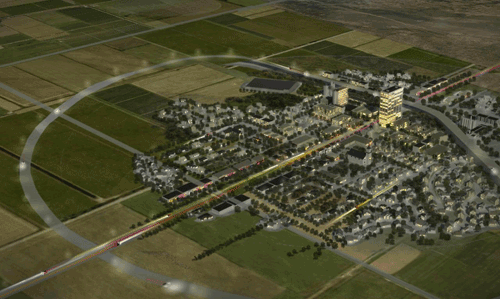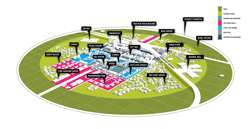Ghost town will be created to test next-generation technology
Area in New Mexico selected as new spot to study future science and technology innovations
Welcome to Hobbs, New Mexico. Population: zero. Well, not exactly zero . . . yet. Pegasus Global Holdings, a private international technology development firm, has selected an area near Hobbs to become the largest scale testing and evaluation center in the world.
The area, referred to as the Center for Innovation, Testing and Evaluation (CITE), will be a ghost town, and will cost, approximately speaking, $1 billion to construct.

Artist rendering provided by the Center for Innovation, Testing and Evaluation, shows the $1 billion scientific ghost town that will be developed in Lea County near Hobbs, N.M. (AP Photo/Center for Innovation, Testing and Evaluation).
The purpose of this future home to nobody is to provide researchers a facility in which to test science and technology innovations, from intelligent traffic systems and next-generation wireless networks to automated washing machines and self-flushing toilets, all without inconveniencing actual residents.
Background
CITE will be a first of its kind smart city. It will represent a 20th -century American city with a population of 35,000, and be built upon approximately 15 square acres of land.
Bob Brumley, senior managing director of Pegasus Holdings, said CITE will be specifically modeled after the real city of Rock Hill, S.C., and will include similar highways, houses, and commercial buildings, both old and new.

Artist rendering of the CITE ghost town.
While no one will live here, they technically could, as all of the houses will be fully outfitted with necessities like appliances and plumbing.
The area will be pre-wired for data collection, giving researchers the ability to simulate system-wide scenarios and then draw data from such activities.

Artist rendering of the CITE data center.
All sorts of tests
Researchers will use CITE to test new technologies on existing infrastructure without interfering with everyday resident life.
“The only thing we won’t be doing is destructive testing, blowing things up — I hope,” Brumley said.
Some of the already planned tests include:
Green Energy
CITE will provide unique opportunities to drill down into the cost of introducing solar, wind, and Smart Grid technologies in a real world setting as a means for determining the next steps to success.
Intelligent Transportation Systems
CITE will provide a highway infrastructure that will allow researchers to test and evaluate unmanned vehicle technologies, traffic management systems, and vehicle-based applications without endangering other drivers.
Homeland Security
CITE will include a secure testing area for first responder technology. A unique benefit of the program is the proximity to both the civil and commercial infrastructure — researchers will be able to test a variety of security scenarios.
Next Generation Wireless Infrastructure
CITE will provide the grounds for the development, installation, testing, and commercialization of high speed broadband technologies across all sectors of the economy.
Location, location, location
The facility will really help diversify the economy of the nearby community, according to Hobbs Mayor Sam Cobb. “It brings so many great opportunities and puts us on a world stage,” he said.
Pegasus did actually look at several other areas, but after scouring the country for potential sites, “. . . we kept coming back to New Mexico,” said Brumley. “New Mexico is unique in so many ways.”
One big plus for New Mexico was its federal research facilities, like White Sands Missile Range in southern New Mexico and Los Alamos, as well as access to Sandia national labs.
Governor Susana Martinez joined officials in announcing final site selection for the project, which came down to Hobbs and nearby Las Cruces. She hailed the project as “one of the most unique and innovative” economic development projects the state has ever seen, and noted that no tax breaks were given for the development. “The only thing they have asked for is guidance,” she said.
Outlook
Brumley said plans are to break ground on CITE by June 30th , 2012. Initial development costs are estimated at $400 million, but Brumley predicts that the overall investment for the project will exceed $1 billion.
CITE is expected to create 350 permanent jobs, and about 3,500 indirect jobs in its design, development, construction, and ongoing operational phases. Learn more at the CITE website. ■
Story via: The Associated Press
Advertisement
Learn more about Electronic Products Magazine





